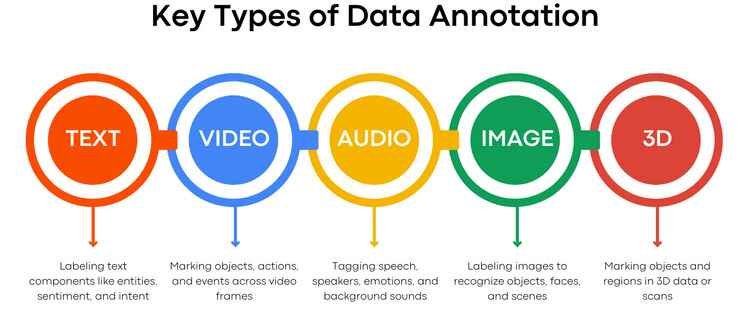Does your AI model work perfectly in the lab, but when deployed, it starts misinterpreting? Because the labeled data used to train it didn’t account for real-world variations. This is the power – and peril – of data labeling. It’s the unsung hero of AI, but it’s also where things often go wrong.
1. Image Annotation: Teaching Machines to See
Let’s be honest: drawing boxes around cars or tagging stop signs sounds simple. But when you’re dealing with thousands of high-resolution images, it’s anything but. Used For:
- Self-driving cars recognizing pedestrians and traffic signs.
- Medical AI detecting tumors in X-rays or MRIs.
- E-commerce platforms tagging products for search.
The Challenges:
- Ambiguity: Is that a dog or a wolf? Context matters.
- Scale: Labeling millions of pixels is tedious and time-consuming.
- Bias: If your labelers only tag stop signs from one country, your AI might fail elsewhere.
Here’s a real-world horror story to illustrate. In 2018, a self-driving car mistook a white truck for the sky because of a mislabeled image. The result? A fatal crash. This tragic example shows why data labeling is a huge responsibility.
Pro Tip: Use tools like Labelbox or CVAT to streamline the process, but don’t skimp on quality control.
2. Text Annotation: Teaching Machines to Read
Text annotation is like teaching a child to read, except the child is a computer, and the books are millions of tweets, reviews, and articles. ChatGPT was trained on massive amounts of annotated text data. Without accurate labeling, it might produce gibberish or offensive content. Used For:
- Chatbots understanding user queries.
- Sentiment analysis for marketing campaigns.
- Machine translation for global communication.
The Challenges:
- Subjectivity: Is “This is sick!” positive or negative?
- Ambiguity: Words like “bank” can mean a financial institution or a riverbank.
- Scale: Labeling millions of words is a massive undertaking.
Pro Tip: Use tools like Prodigy or spaCy to automate parts of the process, but always have humans review the results. Machines still struggle with nuance.
3. Audio Annotation: Teaching Machines to Listen
Imagine training a voice assistant with mislabeled audio. “Hey Siri, call Mom” turns into “Hey Siri, order pizza.” Not ideal, right? Used For:
- Voice assistants like Siri and Alexa.
- Speech-to-text systems for transcription services.
- Sound recognition for security systems (e.g., glass breaking).
The Challenges:
- Noise: Background sounds can make annotation a nightmare.
- Accents and Dialects: A model trained on American English might struggle with Indian English.
- Subjectivity: Emotions in speech can be interpreted differently by different labelers.
A Real-World Example: A voice assistant designed for the U.S. market failed in the UK because it couldn’t understand regional accents. The fix? More diverse audio labeling.
Pro Tip: Use tools like Audacity or Descript to transcribe and annotate audio, but always test your model in real-world conditions.
4. Video Annotation: Teaching Machines to Watch
Video annotation is like image annotation, but with an added dimension: time. It’s the backbone of applications like surveillance, sports analysis, and video content recommendation. Used For:
- Surveillance systems detecting suspicious activities.
- Sports analytics tracking player movements.
- Video platforms recommending content based on user preferences.
The Challenges:
- Complexity: Videos contain more data than images, making annotation labor-intensive.
- Consistency: Objects and actions must be labeled consistently across frames.
- Storage and Processing: High-resolution videos require significant computational resources.
A Real-World Example: A surveillance system flagged a harmless umbrella as a weapon because of inconsistent labeling. The result? False alarms and wasted resources.
Pro Tip: Use tools like VIA or LabelMe Video to manage large-scale video annotation projects, but always have a human in the loop to catch errors.
The Common Thread: Quality Matters
The quality of labeling is paramount, no matter the type of data. Here’s how to ensure quality:
- Clear Guidelines: Provide detailed instructions to labelers.
- Quality Control: Use multiple labelers and cross-check their work.
- Iterative Feedback: Continuously refine the labeling process based on model performance.
The Future of Data Labeling
As AI systems become more sophisticated, so do the demands on data labeling. Emerging trends include:
- Automated Labeling: Using AI to pre-label data, which humans then refine.
- Active Learning: Prioritizing the most informative data points for labeling.
- Synthetic Data: Generating labeled data algorithmically to reduce reliance on human effort.
Need Help with Data Labeling?
AI developers and data science specialists at S-PRO build high-quality, annotated datasets for AI systems. From image segmentation to audio transcription, they’ll ensure your data is ready for training. And yes, their first consultation is free – because great AI starts with great data.
